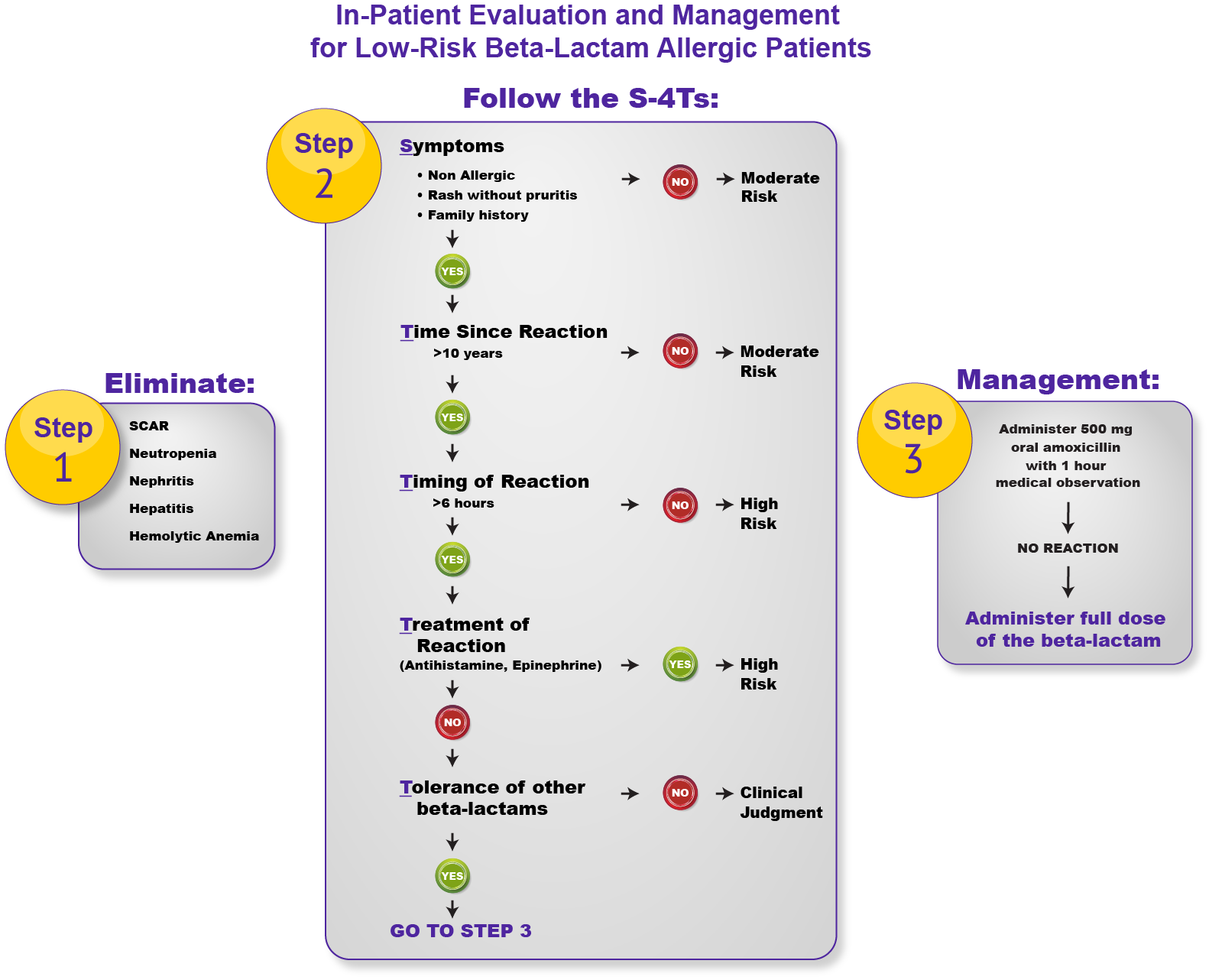
The key to penicillin allergy delabeling
Risk stratification
Key Points
Stratification of patients by allergy history
Intolerance histories
- isolated GI (diarrhea, nausea, vomiting, abdominal pain)
- chills
- headache
- fatigue
Low-risk allergy histories
- family history
- remote (>10 yrs ago) reaction
- pruritis without rash
- unknown (reaction > 10 yrs ago)
Moderate-high risk allergy histories (potential (IgE reactions)
- anaphylaxis
- cough
- throat tightness
- SOB
- wheezing
- chest tightness
- angioedema/swelling
- hypotension
- syncope/pass out
- rash (timing/type)
High-risk (potential severe non-immediate reactions)
- blistering/peeling of skin
- blistering on sores of mucous membranes (e.g. mouth/eyes)
- joint pain/swelling
- rash with
- mucosal lesions
- pustules
- target lesions
- eosinophilia
- liver/kidney injury
- thrombocytopenia
- fever
** Remember:
Most patients that have a documented beta-lactam allergy have a low-risk history (>95%) but moderate and high-risk patients although uncommon must be excluded by a detailed history.
CAN YOU DO A RISK STRATIFICATION FOR BETA-LACTAM ALLERGIC PATIENTS?
Performing a comprehensive history is essential for proper evaluation of a patient with a reported penicillin allergy. There are no validated allergy history questionnaires or uniformly accepted risk levels currently. Allergy history tools should incorporate the time course of the reaction as well as the reaction details.
There are 3 general categories of rashes in drug allergy practice that can occur as a result of a beta-lactam allergy:
- IgE-mediated
- onset minutes to hours
- urticarial
- raised/pruritic
- T-lymphocyte mediated
- onset days
- less pruritic/non-pruritic compared to IgE-mediated reaction
- fine desquamation
- SCAR (severe T-cell mediated reactions or Severe Cutaneous Adverse Reaction)
- onset days to weeks
- blistering/skin desquamation
- mucosal and/or organ involvement
- usually require hospitalization
After the allergy history has ruled out SCAR, hemolytic anemia, an organ-specific reaction(e.g. acute interstitial nephritis), drug fever, or serum sickness, patients can be stratified into low, moderate, and high-risk categories. Based on a patient’s beta-lactam allergy history and risk category, providers can decide if penicillin skin testing or drug challenges are appropriate or if the patient should be referred to an allergist for further evaluation/testing.
Low-Risk History
Low-risk penicillin allergy histories include patients who have had
- isolated nonallergic symptons (e.g. gastrointestinal symptoms, headache, etc…)
- patients solely with a family history of a penicillin allergy
- pruritis without a rash
- remote (>10 years) reaction
Most patients that have a documented penicillin allergy have low-risk histories (> 95%)
Moderate-Risk History
Moderate-risk histories include patients who have had urticaria or other pruritic rashes or reactions with features of IgE-mediated reactions (e.g. swelling) but not anaphylactic reactions.
High-Risk History
High-risk reactions include:
- anaphylaxis
- positive skin testing results
- recurrent penicillin reactions
- hypersensitivities to multiple beta-lactam antibiotics
- SCAR

